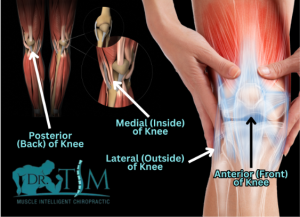Knee pain is a common issue that affects individuals of all ages and lifestyles. Understanding the precise location of your knee pain can significantly enhance the effectiveness of your treatment plan. At Muscle Chiropractic in Glendale, AZ, Dr. Tim specializes in using detailed knee pain location charts to diagnose and treat various knee conditions. This objective approach ensures targeted and efficient pain management, allowing patients to return to their daily activities with minimal discomfort.
Understanding Knee Pain Location Charts
A knee pain location chart is a visual tool that helps identify the specific areas of the knee where pain is experienced. This chart divides the knee into several regions, including the front (anterior), back (posterior), inside (medial), and outside (lateral) parts. Each region is associated with different potential causes and conditions.
Benefits of Using a Knee Pain Location Chart
- Accurate Diagnosis: Pinpointing the exact location of pain helps in identifying the underlying cause, whether it’s related to muscles, ligaments, tendons, or bones.
- Targeted Treatment: Specific treatments can be applied to the affected area, increasing the likelihood of effective pain relief and recovery.
- Personalized Care: Treatment plans can be tailored to the individual’s unique condition and pain pattern.
Common Knee Pain Locations and Their Implications
 Knee Pain Location Chart
Knee Pain Location Chart
1. Anterior Knee Pain
- Common Causes: Patellar tendinitis, quadriceps tendinitis, chondromalacia patella.
- Suggested Treatments: Strengthening exercises, patellar taping, chiropractic adjustments to improve knee alignment.
2. Posterior Knee Pain
- Common Causes: Baker’s cyst, hamstring tendonitis, posterior cruciate ligament injuries.
- Suggested Treatments: Hamstring stretches, ice therapy, chiropractic adjustments to relieve tension in the posterior knee area.
3. Medial Knee Pain
- Common Causes: Medial meniscus tears, MCL (medial collateral ligament) injuries, arthritis.
- Suggested Treatments: Strengthening the inner thigh muscles, manual therapy, specific knee adjustments.
4. Lateral Knee Pain
- Common Causes: Iliotibial (IT) band syndrome, lateral meniscus tears, LCL (lateral collateral ligament) injuries.
- Suggested Treatments: IT band stretches, foam rolling, chiropractic adjustments to address imbalances.
Chiropractic Care for Knee Pain at Muscle Chiropractic
At Muscle Chiropractic, Dr. Tim utilizes a holistic approach to knee pain management, combining chiropractic care with other therapeutic modalities. Here’s what you can expect from a typical knee pain treatment plan:
- Initial Assessment: A thorough examination using a knee pain location chart to determine the exact source of pain.
- Customized Treatment Plan: Based on the assessment, a personalized plan that may include chiropractic adjustments, exercises, and lifestyle recommendations.
- Regular Monitoring and Adjustments: Continuous evaluation and modification of the treatment plan to ensure optimal results.
Suggested Self-Care Tips
- Regular Stretching: Incorporate daily stretches targeting the hamstrings, quadriceps, and IT band to help with knee pain relief.
- Strength Training: Engage in exercises that strengthen the muscles around the knee, such as leg presses and squats.
- Proper Footwear: Wear supportive shoes that help maintain proper alignment and reduce knee strain.
- Healthy Weight Management: Maintaining a healthy weight to decrease the load on your knees.
Addressing Specific Knee Pain Concerns
- Pain Behind Knee: Often related to conditions like Baker’s cyst or hamstring tendonitis. Treatment includes hamstring stretches and chiropractic adjustments.
- Back of Knee Pain: Can be a result of posterior cruciate ligament injuries. Chiropractic care can provide targeted relief through specific adjustments.
- Knee Pain When Bending: This common issue can be addressed by strengthening exercises and proper knee alignment through chiropractic care.
Conclusion
Using a knee pain location chart in conjunction with chiropractic care provides a powerful approach to managing knee pain effectively. At Muscle Chiropractic in Glendale, AZ, Dr. Tim and his team are dedicated to helping patients achieve pain relief and improved mobility through precise, targeted treatments. If you’re experiencing knee pain, including pain behind the knee or back of knee pain, contact Muscle Chiropractic at (480) 740-9619 to schedule an appointment and start your journey toward better knee health.
For more information and to see the knee pain location chart, visit our website or follow us on social media.

